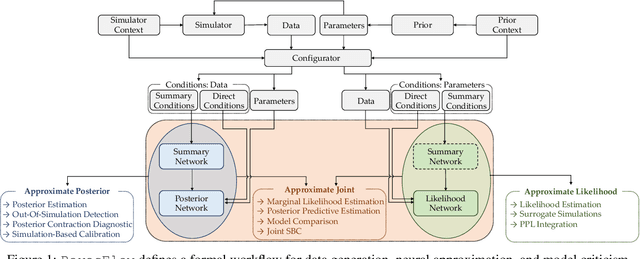Lukas Schumacher
BayesFlow: Amortized Bayesian Workflows With Neural Networks
Jul 10, 2023
Abstract:Modern Bayesian inference involves a mixture of computational techniques for estimating, validating, and drawing conclusions from probabilistic models as part of principled workflows for data analysis. Typical problems in Bayesian workflows are the approximation of intractable posterior distributions for diverse model types and the comparison of competing models of the same process in terms of their complexity and predictive performance. This manuscript introduces the Python library BayesFlow for simulation-based training of established neural network architectures for amortized data compression and inference. Amortized Bayesian inference, as implemented in BayesFlow, enables users to train custom neural networks on model simulations and re-use these networks for any subsequent application of the models. Since the trained networks can perform inference almost instantaneously, the upfront neural network training is quickly amortized.
Neural Superstatistics: A Bayesian Method for Estimating Dynamic Models of Cognition
Nov 30, 2022Abstract:Mathematical models of cognition are often memoryless and ignore potential fluctuations of their parameters. However, human cognition is inherently dynamic, regardless of the reference time scale. Thus, we propose to augment mechanistic cognitive models with a temporal dimension and estimate the resulting dynamics from a superstatistics perspective. In its simplest form, such a model entails a hierarchy between a low-level observation model and a high-level transition model. The observation model describes the local behavior of a system, and the transition model specifies how the parameters of the observation model evolve over time. To overcome the estimation challenges resulting from the complexity of superstatistical models, we develop and validate a simulation-based deep learning method for Bayesian inference, which can recover both time-varying and time-invariant parameters. We first benchmark our method against two existing frameworks capable of estimating time-varying parameters. We then apply our method to fit a dynamic version of the diffusion decision model to long time series of human response times data. Our results show that the deep learning approach is very efficient in capturing the temporal dynamics of the model. Furthermore, we show that the erroneous assumption of static or homogeneous parameters will hide important temporal information.
 Add to Chrome
Add to Chrome Add to Firefox
Add to Firefox Add to Edge
Add to Edge